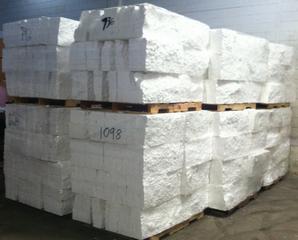By Jim Johnson
SENIOR STAFF REPORTER
Published: September 25, 2014 11:28 am ET
Updated: September 25, 2014 11:32 am ET

Image By: Sebright Products Inc.
Expanded polystyrene prepared for recycling.
Recycling of the expanded polystyrene used in transport packaging continues to rise, extending what has now been a years-long push even higher.
New statistics from the EPS Industry Alliance, a trade group, indicates that this segment of the EPS market recycled 34 percent of its production in 2013, up from 30 percent just the year before.
Six years ago, in 2008, the number was under 20 percent, the Crofton, Md.-based alliance said.
Now slicing and dicing the markets for all the different types of plastics out there can get confusing, and the world of EPS is no different.
The EPS Industry Alliance concerns itself with EPS that’s not used in food service — those cups and plates and to-go containers. Instead, the group focuses on EPS used as transport packaging — all of foam that’s used to cushion the expensive vacuum cleaner or flat screen TV or lighting fixture you buy.
“We’re really proud of our number,” said Betsy Steiner, executive director of the alliance, in a recent conversation. “We’ve worked very, very hard. Our industry has been very diligent.”
The recycling rate for this segment of the EPS industry was at 19.5 percent just six years ago, up just slightly from 19.3 percent in 2006. Recycling numbers started to increase significantly in the years that followed, first up to 28 percent in 2010 and then 30 percent in 2012, the alliance reported.
The 34 percent recycling rate for 2013, just released in a new report by the trade group, translates into a total of 72.8 million pounds of material from post-consumer and post-commercial sources.
“I think that the big takeaway is that two things are influencing this,” Steiner said. “Companies are at a stage where they are reaching the bottom of the barrel ... and starting to work on some of the, let’s say, less mainstream materials.”
In other words, those firms have worked to put in place recycling programs for items such as paper, metals and other plastics. Now with that complete, they can focus their energies on smaller streams of materials such as EPS.
“If they already gathered all the low-hanging fruit, now they are reaching a little bit more. And they are figuring out ways they can recycle materials that might be a little more challenging,” Steiner said.
Another factor is the pricing stability of recycled EPS has companies putting more focus on EPS rather than simply throwing the material away or allowing recyclers to haul it off at no cost.
“Supply and demand and price fluctuations have been very favorable. We see that’s creating demand for siting densifiers. And the more densifiers we have in place for EPS, the more we’re going to be able to grow the collection rate and the numbers,” the executive director said.
These units are important for the transportation economics of recycling EPS, which contains 98 percent air before densification.
The alliance also keeps track of material from post-industrial sources, and that accounted for another 54.5 million pounds for a total of 127.3 million pounds in 2013.
But the industrial number is down from 56.9 million pounds the year before. Steiner characterizes the decrease as negligible and is willing to wait for another year’s numbers before making any conclusions.
“Historically, we’ve seen consistent growth in the industrial area,” she said.
One factor could be that companies that create products from EPS have taken steps to decrease the amount of scrap created from their operations.
“We know our member companies have perfected their in-house operations on getting their scrap down, minimizing scrap,” Steiner said. “They are looking at ‘How can I minimize the amount of scrap they are producing in the first place?’ So that would be one factor.”
The 34-percent recycling rate for post-consumer and post-commercial EPS also stacks up against a nationwide municipal solid waste recycling rate 34.5 percent in 2012.
But, still, EPS is often misunderstood when it comes to recycling.
“We definitely see an improvement,” Steiner said about the public perception of EPS. “We’re not there yet.”
The executive director added that “there’s a lot more critical thinking now” that’s resulting in more consumers being surprised by EPS recycling as opposed to the negative reaction in the past.
Data for report, available at www.epsindustry.org, comes from 41 EPS manufacturers and independent recyclers. | 